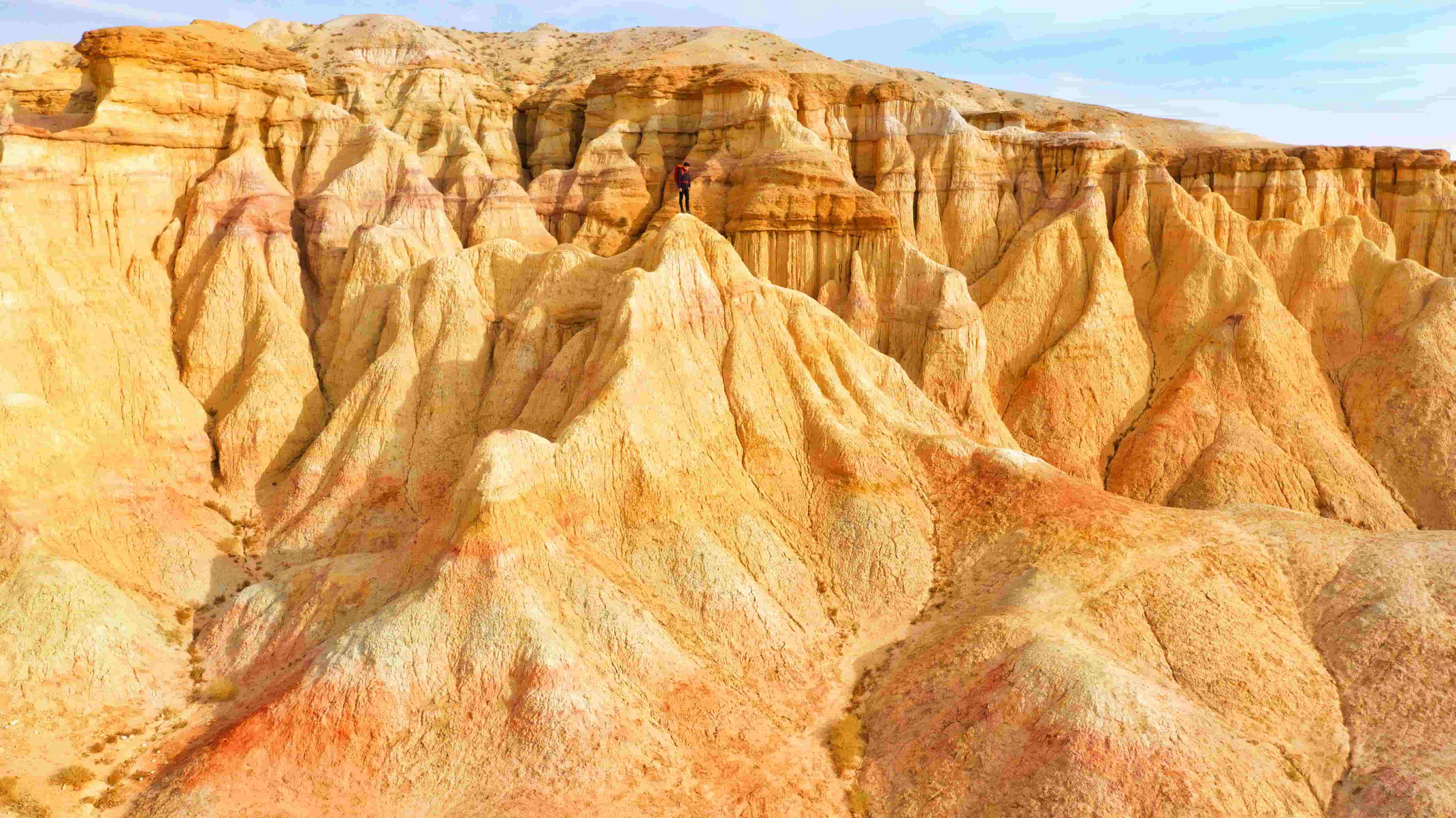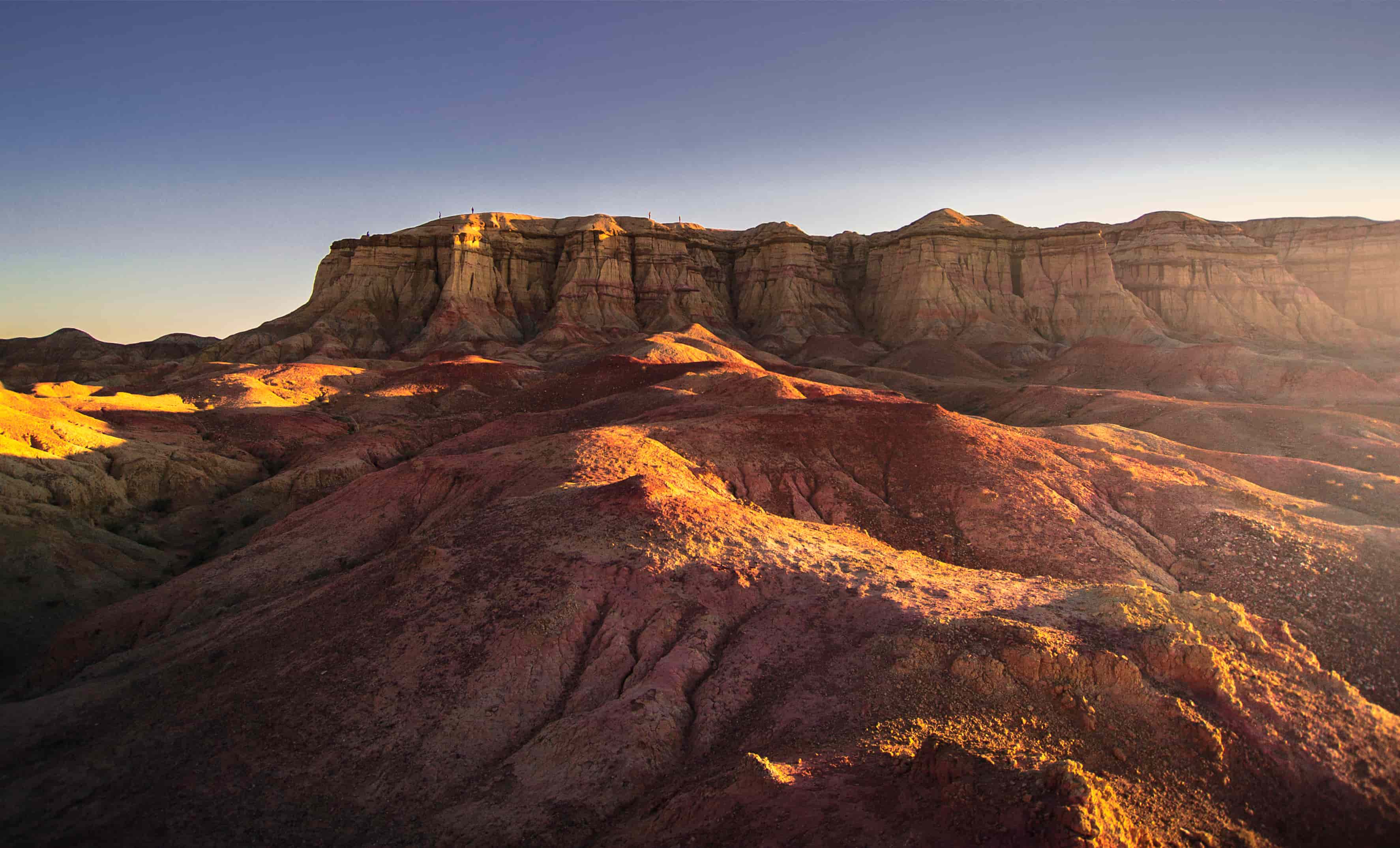Tsagaan Suvarga White Stupa in the Gobi
Contact us for travel suggestions
Exploring Tsagaan Suvarga: The Majestic White Stupa of the Gobi Desert
If you’re on the hunt for Mongolia’s geological secrets, Tsagaan Suvarga is the ultimate treasure of the Gobi Desert. Not just a majestic cliff, but a former seabed sculpted over ages, it towers at over 60 meters, flashing hues that narrate the Earth’s deep past. Visit Tsagaan Suvarga for an authentic encounter with the timeless Gobi, where culture and geology intertwine. The White Stupa is located on the drive from Ulaanbaatar to the Gobi desert and part of several AVIS self drive tour itineraries.
Key Takeaways
- Tsagaan Suvarga, located in Mongolia’s Gobi Desert, is a striking geological formation, formed from a sedimentary structure of an ancient seabed and rich in minerals that give it a vibrant palette of colors.
- The optimal timeframe to visit Tsagaan Suvarga is between May and October, with May, June, and September offering the most favorable weather conditions and longer daylight for exploration.
- Tsagaan Suvarga not only boasts geological and aesthetic value but also holds cultural significance to Mongolia, resembling Buddhist stupas and embodying prosperity and harmony within Mongolian beliefs.
Discovering Tsagaan Suvarga: A Geological Marvel in Mongolia

Hidden within the infinite canvas of the Gobi Desert, the Tsagaan Suvarga is a testament to the relentless march of geologic time. Its sedimentary structure is a chronicle of a former seabed, formed over millions of years. The stupa’s vibrant displays are attributed to a variety of ores and chemical compositions, including iron and calcium, lending it a stunning palette of colors that mesmerize its visitors.
The spectacle of Tsagaan Suvarga truly comes alive after a rainfall. As water cascades down the scarp, it gives the tsagaan suvarga white stupa the appearance of a substantial waterfall, showcasing its impressive length. Tsagaan Suvarga, located in the Dundgobi Aimag or Middle Gobi Province, stands over 60 meters at its highest point and spans a staggering 400 meters in length.
This geological marvel, with its vibrant colors and imposing form, is a must-visit destination in Mongolia. Whether you’re a seasoned adventurer or a curious traveler, Tsagaan Suvarga offers a unique geologic experience unlike any other.
Journey to Tsagaan Suvarga: Navigating the Gobi
A journey through the diverse terrains of the Gobi Desert is necessary to truly appreciate the grandeur of Tsagaan Suvarga. Here are some tips for your trip:
- Chart your course with a reliable 4x4 vehicle equipped with good tires, a spare tire, and a tire jack.
- The typical route from the Gobi Desert to Tsagaan Suvarga involves traveling through Ulaanbaatar, Yolyn Am, Dundgovi province, and finally reaching Tsagaan Suvarga.
- Use navigation applications such as Maps.me to help ensure efficient navigation.
The road conditions in the Gobi desert can vary; certain areas may be slow and challenging, especially after rains, but overall, the terrain is firm and dry, allowing for driving in most areas. Keeping small denominations of cash on hand for toll road payments is recommended while en route to Tsagaan Suvarga, as you may encounter temples or other attractions requiring entrance fees.
The Optimal Time for Visiting Tsagaan Suvarga
Between May and October is the prime time to visit Tsagaan Suvarga, with May, June, and September being particularly popular. During these months, the average temperature in Tsagaan Suvarga is above 56°F, with temperatures in September ranging from 60°F to 47°F. These months provide warmer weather and longer daylight hours, making it an ideal time for exploration and adventure.
The best times to visit Tsagaan Suvarga are:
- May and June, with their pleasant temperatures
- Late August or early September, during the ‘Ikh’ festival
- June, which has approximately 9 hours and 54 minutes of sunshine per day
These times offer optimal conditions for exploration and enjoyment of the north area, making it one of the best destinations.
Activities Around the White Stupa
Beyond its stunning visuals, Tsagaan Suvarga offers a plethora of activities for the adventurous traveler. For hiking enthusiasts, the trails around Tsagaan Suvarga prove to be a thrilling experience. These trails present opportunities to explore the cliff top and the rolling hills below, promoting a deeper appreciation for the unique geological features of Tsagaan Suvarga.
Another intriguing attraction is the Khevtee Bosoo Cave, situated 7 km to the east of Tsagaan Suvarga. This cave offers distinctive spelunking experiences with spaces both large and small for visitors to crawl or stand up in.
For those interested in history, Tsagaan Suvarga has plenty to offer. Ancient rock drawings located near Tsagaan Suvarga provide a historical dimension to visitors’ adventures.
Accommodation Options in Dundgovi Province
After a full day of exploration and adventure, you’ll need a comfortable place to rest. The area around Tsagaan Suvarga offers various lodging options. These consist of ger camps and family-operated guest gers, providing a convenient stopover between Dalanzadgad and Mandalgobi cities.
A Ger camp in Mongolia represents a traditional lodging option allowing guests to reside in gers, which are customary portable dwellings utilized by the nomadic population of Mongolia. Ger camps frequently include a spacious central ger or lodge-style restaurants for offering Mongolian and European cuisine. Online platforms such as Amicus Mongolia and Travel Gobi Mongolia facilitate reservations for stays in Ger camps near Tsagaan Suvarga.
A family-operated guest Ger near Tsagaan Suvarga usually offers the following amenities:
- Single bed private Ger
- Budget double/Twin bed Ger
- Triple bed Ger
- Family ger with 1 double bed and 2 extra beds
The prices vary, ranging from $28 USD per night for a single bed Ger to $60 USD per night for a family ger.
Camping Tips for the Adventurous Traveler
For those who prefer to be closer to nature, camping could be a preferred option. Consider using rooftop tents from Roofnest, Thule, iKamper, and CVT when camping in Mongolia. In terms of clothing, it is recommended to utilize a 3-layer system that is suitable for Mongolia’s climate. This system should consist of a moisture-wicking base layer, an insulating middle layer made of wool or polar fleece, and a weatherproof outer layer such as fleece or a down jacket.
For a portable gas stove in Mongolia, the Coleman Fold N Go 2-Burner Propane Camping Stove is recommended due to its compact design, foldability, and easy transportability.
Make sure to pack an adequate supply of food and water for the entire duration of your camping trip in the Gobi Desert. It is recommended to carry a week’s worth of supplies, including essential items like tea, coffee, bread, biscuits, and spread for breakfast, as well as two courses of your choice for both lunch and dinner.
Cultural Significance of Tsagaan Suvarga

Tsagaan Suvarga is not just a geological marvel; it holds a deep cultural significance. Its resemblance to Buddhist stupas and its location in the sacred Gobi Desert add to its cultural importance. Buddhist stupas hold significant importance in Buddhist architecture and can be found in all Buddhist temples and monasteries. Originally, they served as tombstones containing the remains of Buddha or other important Buddhist figures.
In Mongolian culture, stupas hold significance as they are believed to:
- Bring prosperity
- Bring harmony
- Help prevent natural disasters by pacifying harmful energies
- Serve as housing for sacred objects and relics of Buddhist masters to amplify their power.
Nearby Attractions: Exploring More of Mongolia’s Wonders
The adventure doesn’t stop at Tsagaan Suvarga. The nearby attractions to Tsagaan Suvarga comprise the Khongor Sand Dunes, which is the largest attraction in the Mongolian Gobi, and other intriguing sites within the Gobi Desert. The Khongor Sand Dunes, also referred to as Khongoriin Els, hold considerable significance as the primary sand mass within the Gobi Gurvan Saïkhan National Park, spanning over 900 square kilometers and attaining elevations of up to 800 meters in certain regions.
Driving is the most efficient transportation method from Tsagaan Suvarga to Khongor Sand Dunes and other Gobi Desert attractions in Dundgobi Province. The Gobi Desert in the vicinity of Tsagaan Suvarga is inhabited by wildlife including:
- Bactrian camel
- Gazelles
- Argali sheep
- Ibex
- A variety of bird species
How to drive to Tsagaan Suvarga from Ulaanbaatar
Embarking on a journey from Ulaanbaatar to Tsagaan Suvarga is an experience in itself. Here are some details about the journey:
- The distance between Ulaanbaatar and Tsagaan Suvarga is approximately 420 km.
- The estimated travel time by car is about 7 hours.
- The last hour of the journey is completely off-road, adding an extra thrill to your adventure.
- Considering comfort and the challenging terrain, using a reliable 4x4 vehicle like the Toyota Land Cruiser Prado is recommended for the journey to Tsagaan Suvarga.
Car rental service in Ulaanbaatar Avis offer appropriate 4x4 vehicles for journeys to Tsagaan Suvarga. Travelers should expect a range of road conditions, including rough and bumpy sections and potential obstacles. It is advisable to stay informed about recent reports from fellow travelers and to be adequately prepared for these challenges.
Summary
Tsagaan Suvarga, the White Stupa of the Gobi Desert, is truly a treasure of Mongolia. Its unique geology, cultural significance, and the thrilling adventures it offers make it a must-visit destination for any traveler. From the vibrant displays of the white stupa to the thrill of navigating the Gobi, and the cultural immersion offered by the local accommodations, Tsagaan Suvarga is a journey of discovery that is bound to leave you with unforgettable memories.
So pack your bags, gear up, and embark on this remarkable journey of exploration and adventure. Tsagaan Suvarga, the majestic White Stupa of the Gobi Desert, awaits you!
Frequently Asked Questions
What is the white stupa in China?
The white stupa in China is located at the Miaoying Temple and is a well-preserved cultural relic of the Dadu capital of the Yuan Dynasty, built by Araniko. It serves as a tribute to the historical friendship between China and Nepal.
 White Stupa
White Stupa